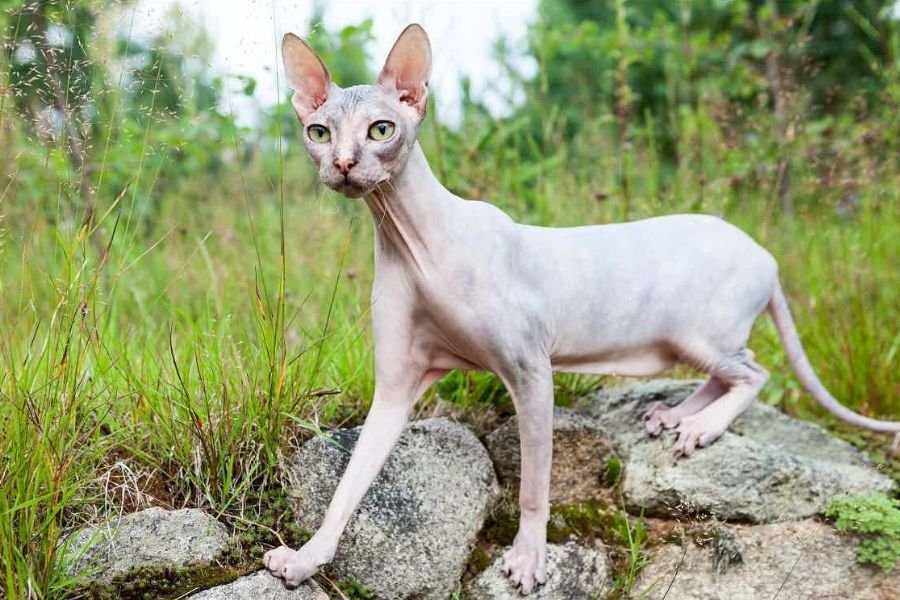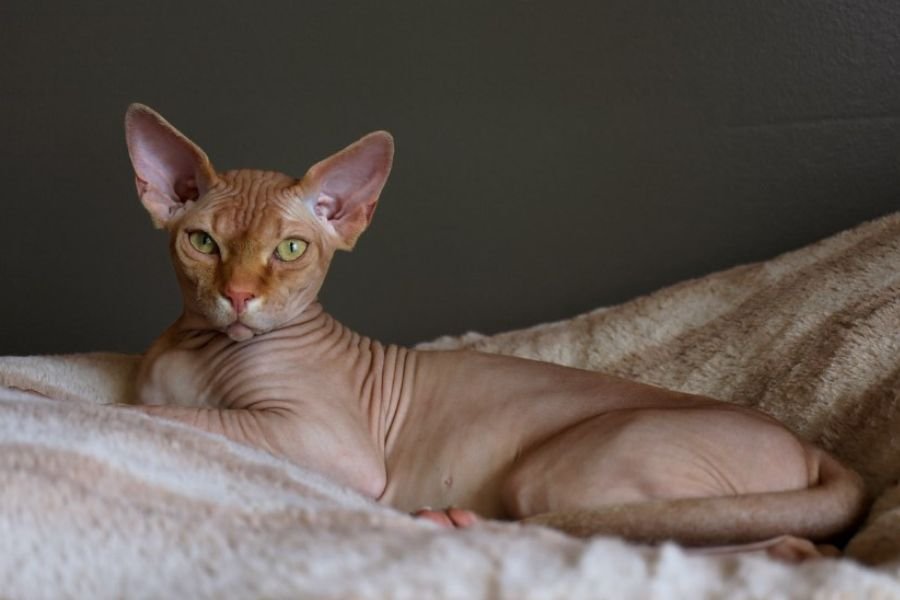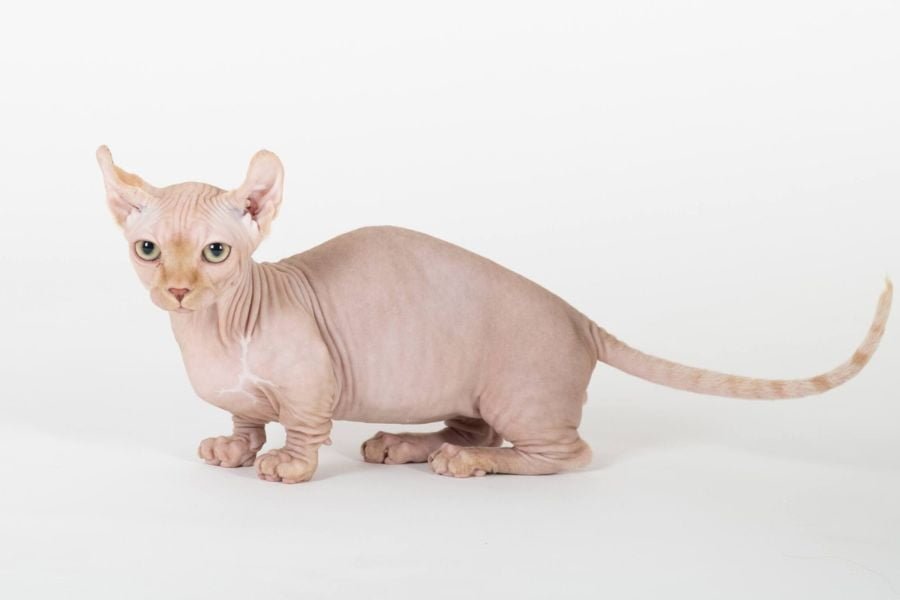Meet 7 hairless cat breeds
We are used to our kitties being always fluffy and furry, our furballs to be cherished. However, there is a fascinating world of hairless cat breeds and, in this article, we are going to meet 7 of them. Increasingly admired around the world, these hairless kitties delight with their charming personalities and quirky looks. Let’s get to know the characteristics and a little bit of the history and origin of these remarkable felines. Enjoy reading and have fun!

Sphynx cat
Let’s start with the most famous model of the hairless cats, the Sphynx cat. The name of this hairless cat breed was chosen due to its resemblance to the sphinx of Giza, Egypt. A curious fact is that this breed originated in a place where hair is much needed because of the cold, in Canada, in 1966. The sphynx are born without hair naturally due to a genetic mutation and over the years, new litters of hairless kittens were born and the breed developed.
If one day you have the opportunity to see a sphynx in person, you will realize that it is not, in fact, totally hairless or bald. Its little body is covered with thin hair, almost invisible and that gives the skin a silky touch, similar to suede. It’s a delight to pet them. Because it is all wrinkled and has several folds in the skin, some specific care is needed for excess oiliness in the skin.
As for behavior, it is a docile, kind cat and extremely affectionate to its human, even with that serious face and that proud and aristocratic look.
It is a medium-sized kitty and its lifespan is around 14 years.
Bambino cat
This is a small-sized hairless kitty, weighing an average of 4 to 7 pounds and no more than 8 inches tall. Its origin is in the United States and its lifespan is 12 to 15 years.
This is new in terms of hairless cats, created by crossing a sphynx with a cat of the Munchkin breed, in 2005. The Munchkin is a kitty that can be considered the “sausage cat of the feline world”, as it has a ‘low silhouette’ as well as the dogs of the Dachshund breed (no wonder it is known as “sausage cat”, right?). It is considered a lap cat and loves to be cuddled up and petted by its human. They are very smart and playful and are always in search of attention.
Donskoy cat or Don Sphynx
These kitties have an interesting feature: they can be born with hair and lose it throughout their lives, becoming completely hairless over time. They originate from Russia, around 1980 when a hairless kitten was found on the street in the city of Rostov-on-Don. Since then, the breed has been improved and today, it is known that felines of the Donskoy or Don Sphynx breed begin to lose their hair from 4 months of age.
They are known to be affectionate, very sociable and extroverted. They are medium to large cats, weighing up to 13 pounds and their lifespan is 12 to 15 years.

Elf cat
This is one of the biggest kitties you will ever see and definitely the largest model of hairless cat breeds. The Elf cat can weigh up to 20 pounds and got its name from the shape of its little ears: they are distinctively curled back naturally, reminiscent of the ears of elves in the fantasy genre.
The Elf cat comes from the crossing of a sphynx and an American Curl breed. They are robust, muscular, and have an elegant and proud look. They love to interact with their humans, they are sociable with other humans, they are intelligent, and they like to learn new tricks and games. The lifespan of this kitty is 12 to 15 years, but there are cases of individuals that reached 20 years.
Ukrainian Levkoy cat
The Elf cat has its ears curved backward, while the Ukrainian Levkoy cat has them curved forward and that makes it look too cute! This hairless cat breed is the result of a cross between the Donskoy cats and the Scottish fold breed. As their name suggests, they originate from Ukraine and were recognized as a breed as recently as 2011.
As for behavior, they are friendly, enjoy socializing, and are very calm, despite having a lot of physical strength. The lifespan of Ukrainian Levkoy cats is similar to the average for other hairless cat breeds, from 12 to 15 years, and are considered medium to large, weighing from 7 to 13 pounds.
Peterbald cat
These kitties originate from the Russian city of Saint Petersburg and are considered new in terms of a hairless cat breed, which appeared in the 1990s as a result of a cross between the Siamese and Donskoy breeds.
When kittens have extremely thin hair that, as with Donskoy breed kittens, will fall out throughout life. Its skin is not as oily as that of the sphynx and is more like that of the bambino, which makes its care easier.
Their temperament is docile, friendly, interactive, and affectionate, in addition to being very curious. Sociable with other pets, they end up being perfect for family environments. They weigh between 10 and 14 pounds and live the same average as the breeds we mentioned above, from 12 to 15 years.
Dwelf cat
We, here at Proto Animal, fell in love with this kitty when we saw it: the short legs “low style” and its little curled ears give the Dwelf cat one of the most exotic and fluffy looks of the hairless cat breeds. Its name is a combination of the words dwarf and elf, that is, it is a dwarf elf.
All this cuteness is the result of another cross, this time between the Munchkin, from which it inherited the short legs, the American Curl, which gave it the curled little ears, and the Sphynx breeds, from which, it almost goes without saying, it inherited the gene that gives you hairlessness.
Smart ones, they enjoy interaction with their humans and other people, they are sociable and friendly with other pets as well. They are small-sized, weighing an average of 5 to almost 10 pounds as adults. Their lifespan is the same as that of the other breeds mentioned above, from 12 to 15 years.
Taking care of a hairless cat
If you’re lucky enough to have a hairless cat, whether it’s a Sphynx or another hairless cat breed, you know that these unique felines require some special care. Hairless cats, also known as Sphynx cats, are captivating creatures with their smooth, nearly bald bodies. They might be low on fur, but they’re high on personality! In this section, we’ll explore some essential tips to ensure your hairless cat’s well-being.
1. Regular Bathing and Grooming
Hairless cats, including Sphynx cats, don’t have fur to absorb and distribute their natural oils, which can lead to oil buildup on their skin. To keep them clean and odor-free, it’s essential to bathe your hairless cat regularly. Use a mild, hypoallergenic shampoo formulated for cats to prevent skin irritation. Ensure you dry them thoroughly after each bath to prevent chilling.
2. Sunscreen and Protection
Hairless cats are more susceptible to sunburn than their furry counterparts. Their exposed skin can easily get sunburned, so if your hairless cat enjoys basking in the sun, apply a pet-safe sunscreen to their ears, nose, and any other exposed areas. Additionally, consider providing shaded areas for them to relax in during sunny days.
3. Climate Control
Hairless cats are sensitive to temperature changes. During colder months, make sure your home is warm enough to keep them comfortable. Provide cozy blankets and heating pads for them to snuggle up on. In the summer, ensure your home is adequately cooled, as hairless cats can overheat easily.
4. Nutritious Diet
Maintaining a healthy diet is crucial for your hairless cat’s well-being. Consult with your veterinarian to determine the best diet for your specific breed and age. Hairless cats may have higher metabolism rates, so they might require more food than their furry counterparts.
5. Skin Care Routine
Check your hairless cat’s skin regularly for any signs of irritation, rashes, or dryness. If you notice any issues, consult your veterinarian for appropriate skincare products. Some hairless cat breeds are more prone to skin problems, so being proactive is key.
6. Regular Vet Check-ups
Routine veterinary visits are essential for all cats, but especially for hairless cat breeds. Regular check-ups can help identify and address any potential health concerns early on. Ensure your vet is familiar with hairless cats and their unique needs.
7. Social Interaction
Hairless cats are known for their affectionate and social nature. They thrive on human interaction and attention. Spend quality time with your hairless cat, engage in play, and provide mental stimulation to keep them happy and content.
In conclusion, hairless cats, such as Sphynx cats, are wonderful companions that require a bit of extra care due to their lack of fur. By following these tips and understanding the specific needs of your hairless cat breed, you can ensure they lead a healthy, happy life. Remember that every hairless cat is unique, so tailor your care routine to their individual preferences and requirements.
Conclusion
Hairless breeds are exotic and beautiful and require special care for their skin, some because they are too oily and others too little. Another thing in common with all these kittens is the lack of whiskers (vibrissae), which can end up compromising their guide in new environments and their sense of space.
We hope you enjoyed meeting these cuties, but remember: whenever you think of having a feline or canine friend in your family, be careful to acquire them from responsible breeders and always think of the thousands of pets awaiting adoption in homes and NGOs.
Until next time! ♥




